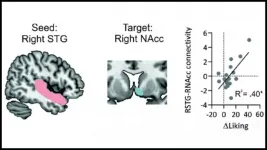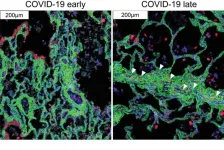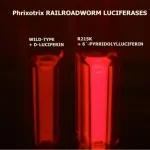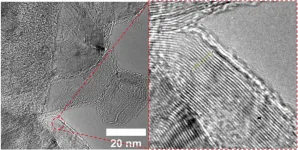INFORMATION:
Funding support for their paper comes from both private foundations and the National Institutes of Health. The private foundations are BrightFocus Foundation, Foundation of Fighting Blindness, Knights Templar eye foundation the Retina Research Foundation and Research to Prevent Blindness.
Other collaborators on the paper include:
At the University of Rochester: Lead author Kannan V. Manian, Chad Galloway, Sonal Dalvi, Anthony A. Emanuel, Jared A. Mereness, Whitney Spencer, Lauren Winschel, Celia Soto, Yiming Li, Yuanhui Song, William DeMaria, and Mina Chung.
At the University of Wisconsin: Akhilesh Kumar, Igor Slukvin, Michael P. Schwartz, and William L. Murphy.
At the Cleveland Clinic Cole Eye Institute: Bela-Anand Apte
Lab model offers hope for macular degeneration patients
3D lab model using patient-derived tissues could lead to individual treatments or cure
2021-03-29
(Press-News.org) Age-related macular degeneration (AMD), which leads to a loss of central vision, is the most frequent cause of blindness in adults 50 years of age or older, affecting an estimated 196 million people worldwide. There is no cure, though treatment can slow the onset and preserve some vision.
Recently, however, researchers at the University of Rochester have made an important breakthrough in the quest for an AMD cure. Their first three-dimensional (3D) lab model mimics the part of the human retina affected in macular degeneration.
Their model combines stem cell-derived retinal tissue and vascular networks from human patients with bioengineered synthetic materials in a three-dimensional "matrix." Notably, using patient-derived 3D retinal tissue allowed the researchers to investigate the underlying mechanisms involved in advanced neovascular macular degeneration, the wet form of macular degeneration, which is the more debilitating and blinding form of the disease.
The researchers have also demonstrated that wet-AMD-related changes in their human retina model could be targeted with drugs.
"Once we have validated this over a large sample, the next hope would be to develop rational drug therapies and potentially even test the efficacy of a specific drug to work for individual patients," says Ruchira Singh, an associate professor of ophthalmology at the University's Flaum Eye Institute.
The lab of Danielle Benoit, professor of biomedical engineering and director of the Materials Science Program, engineered the synthetic materials for the matrix and helped configure it, as described in a paper in Cell Stem Cell.
Singh says the findings should help resolve a "huge" debate among researchers in the field who have been trying to determine whether:
Defects in the retina itself are responsible for the disease (and if so, which parts of the retina are responsible); or
The disease is caused by other "systemic issues," for example, in blood supply.
Their research points strongly to retinal defects as being responsible--and in particular, to defects in an area called the retinal pigment epithelium (RPE), a pigmented cell layer that nourishes the retina's photoreceptor cells.
WHY ANIMAL MODELS FAIL--AND A 3D MODEL PROVED 'ESSENTIAL'
Two areas of the human eye are affected by AMD. They include the RPE and, beneath the RPE, an underlying support system called the choriocapillaris, composed largely of capillaries that feed the outer retina.
Until now, researchers have relied largely on rodent models. But the anatomy and physiology of the human and rodent retinae are very different. According to Singh, it was essential to create "an in vitro human model of the choriocapillaris layer integrated with the RPE to get the entire complex that is affected by this disease."
For example, in a previous study, Singh's lab used only a single retina cell type--patient-derived retinal pigment epithelium (RPE)--to show that symptoms of early and dry forms of AMD could be mimicked in culture, and could be solely caused by dysfunction in the RPE cells. However, the role of the choriocapillarislayer had remained "a mystery that nobody has ever been able to model in culture," she says.
That's why it was so important to develop an in vitro and modular human model that could integrate a choriocapillaris layer with the RPE "to get the entire complex that is affected by this disease, so that properties of each individual cell type can be controlled independently," Singh says.
And that's why Benoit's lab, which specializes in creating synthetic hydrogels for cell culture, tissue engineering, and target drug delivery, was important.
Benoit's lab engineered the 3D matrix in which the choriocapillaris could be safely placed and also "properly oriented in the overall vasculature," Benoit says. "We also facilitated the adhesion of the RPE cells within the model. It was a small, but important contribution. A three-dimensional model was essential to describe the really amazing things that have been identified and discovered using this model."
The findings offer a possible resolution to the debate over the causes of macular degeneration. The researchers now show for the first time that defects in RPE cells alone are sufficient to cause the disease. "You can have completely normal choriocapillaris, but if your RPE's are dysfunctional it will cause the choriocapillaristo dysfunction," Singh says.
Similarly, using blood samples from patients with wet AMD in the human retina model, their data for the first time also shows that blood-derived factors from patients can independently contribute to the development and progression of wet AMD.
The collaborations, Singh says, have succeeded in
Creating an accurate human model of the RPE/choriocapillaris complex
Confirming that RPE and mesenchymal stem cells play a role in the development of the choriocapillarislayer
Mimicking aspects of macular degeneration in the human model
Understanding the role of specific cells types and blood-derived factors in the development of macular degeneration
Targeting the disease, using a drug in a patient derived cell model
WORLD LEADERSHIP IN VISION SCIENCE
The latest research by Singh and Benoit builds on the University of Rochester's long tradition as a world leader in vision science.
In the 1990s, for example, David Williams, the William G. Allyn Professor of Medical Optics, and his group applied adaptive optics--first used in telescopes to more clearly see through the Earth's atmosphere--to image individual retinal cells, right down to single photoreceptors in the living human retina. The work of Williams and his team has had a far-reaching effect on procedures to improve vision and is applied throughout the world in Lasik procedures today.
That legacy attracted both Singh and Benoit to Rochester, but so, too, did another factor: the proximity of the engineering and science departments and the Medical Center--located across an avenue from one another--and the chance to work together. Benoit says that proximity was a "critical" factor in her decision to join the Department of Biomedical Engineering in 2010. Singh says the opportunity to collaborate with Benoit was one of the main reasons she decided to join the Medical Center seven years ago.
It's useful in forging other collaborations as well. Vision science at the University now involves a synergy of science, engineering and medicine across various departments including brain and cognitive sciences, neurobiology and anatomy, and ophthalmology, engaging about 100 Rochester faculty members. The Center for Visual Science, and its ARIA lab, directed by Williams, collaborates closely with the Medical Center's Flaum Eye Institute and is the hub of these collaborations.
ELSE PRESS RELEASES FROM THIS DATE:
Why the brain enjoys music
2021-03-29
Communication between the brain's auditory and reward circuits is the reason why humans find music rewarding, according to new research published in JNeurosci.
Despite no obvious biological benefits, humans love music. Neuroimaging studies highlight similarities between how the brain's reward circuits process music and other rewards like food, money, and alcohol. Yet neuroimaging studies are correlational by nature. In a new study, Mas-Herrero et al. sought to nail down the causal role of this circuitry by using non-invasive brain stimulation.
A group of pop music fans listened ...
New technique provides detailed map of lung pathology in COVID-19
2021-03-29
A team led by investigators at Weill Cornell Medicine and NewYork-Presbyterian has used advanced technology and analytics to map, at single-cell resolution, the cellular landscape of diseased lung tissue in severe COVID-19 and other infectious lung diseases.
In the study, published online March 29 in Nature, the researchers imaged autopsied lung tissue in a way that simultaneously highlighted dozens of molecular markers on cells. Analyzing these data using novel analytical tools revealed new insights into the causes of damage in these lung illnesses and a rich data resource for further research.
"COVID-19 is a complex disease, and we still don't understand exactly what it does to a lot of organs, but with this study we were able to develop ...
Brazilian researchers obtain more efficient red bioluminescence
2021-03-29
Researchers at the Federal University of São Carlos (UFSCar) in the state of São Paulo, Brazil, have developed a novel far red light-emitting luciferin-luciferase system that is more efficient than those available commercially. An article on the subject is published in the International Journal of Molecular Sciences.
The study was supported by São Paulo Research Foundation - FAPESP via the Thematic Project "Arthropod bioluminescence: biological diversity in Brazilian biomes, biochemical origin, structural/functional evolution of luciferases, molecular differentiation of lanterns, biotechnological, environmental and educational applications", for which the principal ...
Remote-friendly student project presentations enable creativity and risk-taking
2021-03-29
ANN ARBOR--In a two-year study that could help guide educators developing the post-pandemic new normal, student groups at the University of Michigan assigned to make video presentations showed more creativity and risk-taking than groups making conventional in-person presentations.
"Given the importance of project-based learning, our study provides a way to turn virtual limitations into an advantage," said Fei Wen, U-M associate professor of chemical engineering. "We can enhance the student experience and learning outcomes."
Higher education, along with society at large, anticipates a shift in the balance between ...
Common medications contain animal byproducts, study finds
2021-03-29
More physicians and pharmacists are advocating for patients to be made aware of animal byproducts contained in common medications, according to new research in the Journal of Osteopathic Medicine. Common medications, including widely used blood thinners and hormones, are often derived from animal byproducts and prescribed without consulting the patient about their beliefs.
"Patients deserve to know what their medications are made of, yet this information is rarely shared," said Sara Reed, student doctor at Lincoln Memorial University (LMU) DeBusk ...
Coastal lupine faces specific extinction threat from climate change
2021-03-29
Climate change is altering the world we share with all living things. But it's surprisingly difficult to single out climate change as an extinction threat for any one particular species protected under the Endangered Species Act.
To date, the U.S. Fish and Wildlife Service has only formally considered impacts from climate change in listing actions for four animal species and one alpine tree.
But the effects of climate change extend to temperate climates as well. A new analysis of population data published in the journal Ecosphere shows that climate change represents a specific extinction threat for an endangered coastal lupine plant.
Biologists including Eleanor Pardini at Washington University in St. Louis have tracked all of the known stands ...
Tires turned into graphene that makes stronger concrete
2021-03-29
HOUSTON - (March 29, 2021) - This could be where the rubber truly hits the road.
Rice University scientists have optimized a process to convert waste from rubber tires into graphene that can, in turn, be used to strengthen concrete.
The environmental benefits of adding graphene to concrete are clear, chemist James Tour said.
"Concrete is the most-produced material in the world, and simply making it produces as much as 9% of the world's carbon dioxide emissions," Tour said. "If we can use less concrete in our roads, buildings and bridges, we can eliminate some of the emissions at the very start."
Recycled tire waste is already used as a component of Portland cement, but graphene has been proven to strengthen cementitious materials, ...
Study looks at impacts of COVID-19 and Cyclone Harold on fishers in Fiji
2021-03-29
SUVA, Fiji (March 29, 2021) - A new study published in the journal Environmental Science and Policy addresses the impacts of COVID-19 and Cyclone Harold on Indo-Fijians engaged in small scale fisheries.
The paper says that countries, including Fiji, need to address ethical and social justice considerations and the politics of recovery efforts by putting vulnerable and marginalized groups front and center in the aftermath of pandemics and natural disasters.
What countries cannot afford is for economic recovery efforts to put additional burdens and risk on those invested in the SSF sector, and cause further widening of inequities, and increase ...
Apes show dramatically different early immune responses compared to monkeys
2021-03-29
A new study out of the University of Chicago and the University of Illinois Urbana-Champaign in humans, chimpanzees, rhesus macaques and baboons has found key differences in early gene expression in response to pathogen exposure, highlighting the importance of choosing the right animal model for the right questions. The study was published on March 26 in END ...
Parents often don't use child car seats in ride-share
2021-03-29
A national survey of parents revealed that most parents who used ride-share services did so with their children, but only half of the respondents reported that children who were 8 years or younger traveled in the recommended child car seats or booster seats when in ride-share vehicles. Among parents of children in this age group, over 40 percent used only a seat belt for their child, while 10 percent allowed their child to travel on a lap or unrestrained. Overall, parents reported lower rates of child car seat use in ride-share compared with how their child usually travels. Findings were published in the journal Academic Pediatrics.
"Our results are concerning, as ...
LAST 30 PRESS RELEASES:
Making lighter work of calculating fluid and heat flow
Normalizing blood sugar can halve heart attack risk
Lowering blood sugar cuts heart attack risk in people with prediabetes
Study links genetic variants to risk of blinding eye disease in premature infants
Non-opioid ‘pain sponge’ therapy halts cartilage degeneration and relieves chronic pain
AI can pick up cultural values by mimicking how kids learn
China’s ecological redlines offer fast track to 30 x 30 global conservation goal
Invisible indoor threats: emerging household contaminants and their growing risks to human health
Adding antibody treatment to chemo boosts outcomes for children with rare cancer
Germline pathogenic variants among women without a history of breast cancer
Tanning beds triple melanoma risk, potentially causing broad DNA damage
Unique bond identified as key to viral infection speed
Indoor tanning makes youthful skin much older on a genetic level
Mouse model sheds new light on the causes and potential solutions to human GI problems linked to muscular dystrophy
The Journal of Nuclear Medicine ahead-of-print tip sheet: December 12, 2025
Smarter tools for peering into the microscopic world
Applications open for funding to conduct research in the Kinsey Institute archives
Global measure underestimates the severity of food insecurity
Child survivors of critical illness are missing out on timely follow up care
Risk-based vs annual breast cancer screening / the WISDOM randomized clinical trial
University of Toronto launches Electric Vehicle Innovation Ontario to accelerate advanced EV technologies and build Canada’s innovation advantage
Early relapse predicts poor outcomes in aggressive blood cancer
American College of Lifestyle Medicine applauds two CMS models aligned with lifestyle medicine practice and reimbursement
Clinical trial finds cannabis use not a barrier to quitting nicotine vaping
Supplemental nutrition assistance program policies and food insecurity
Switching immune cells to “night mode” could limit damage after a heart attack, study suggests
URI-based Global RIghts Project report spotlights continued troubling trends in worldwide inhumane treatment
Neutrophils are less aggressive at night, explaining why nighttime heart attacks cause less damage than daytime events
Menopausal hormone therapy may not pose breast cancer risk for women with BRCA mutations
Mobile health tool may improve quality of life for adolescent and young adult breast cancer survivors
[Press-News.org] Lab model offers hope for macular degeneration patients3D lab model using patient-derived tissues could lead to individual treatments or cure





